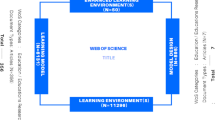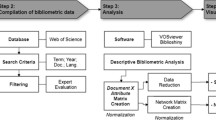Abstract
Although research from the Asia-Pacific region has been increasing, much is unknown about research trends, authors, and institutions in the region, especially in relation to learning and instruction. It is important to have an understanding of current research to identify its strengths and weaknesses and to chart future research directions. It is also useful to identify prominent and productive authors and institutions in the Asia-Pacific to enhance international and regional collaboration between researchers. Twelve top international journals from 2002 to 2011 in the fields of educational psychology, educational technology, and learning sciences were examined. New bibliometric measures, such as the q 2 index, as well as co-authorship network analysis, and cluster analysis methods were utilized to provide insights into Asia-Pacific authors and institutions in the field of learning and instruction research.




Similar content being viewed by others
Notes
This formula from Howard et al. (1987) is used to calculate the credit of an author in a multi-authored article:
$$ {\text{Credit = (1}} . 5^{n - i} )/\left( {\sum\limits_{i = 1}^{n} {1.5^{i - 1} } } \right), $$where n represents the total number of authors and i represents the order of a particular author. For instance, in a three-author article, the first gets 0.47 credit unit; the second gets 0.32; and the third gets 0.21. The sum of credits is always 1 for a single article regardless of the total number of authors.
References
Acedo, F. J., Barroso, C., Casanueva, C., & Galán, J. L. (2006). Co-authorship in management and organizational studies: An empirical and network analysis. Journal of Management Studies, 43(5), 957–983.
Association for Educational Communications and Technology. (2008). Definition. In A. Januszewski & M. Molenda (Eds.), Educational Technology: A definition with commentary (pp. 1–14). New York: Lawrence Erlbaum Associates.
Borgatti, S. P., Everett, M. G., & Freeman, L. C. (2002). Ucinet for Windows: Software for social network analysis. Harvard: Analytic Technologies.
Cabrerizo, F. J., Alonso, S., Herrera-Viedma, E., & Herrera, F. (2010). q2-index: Quantitative and qualitative evaluation based on the number and impact of papers in the Hirsch core. Journal of Informetrics, 4(1), 23–28.
Chou, C. P. (2014). The SSCI syndrome in Taiwan’s academia. Education Policy Analysis Archives, 22(29). doi:10.14507/epaa.v22n29.2014.
Durbach, I. N., Naidoo, D., & Mouton, J. (2008). Co-authorship networks in South African chemistry and mathematics. South African Journal of Science, 104(11/12), 487–492.
Eaton, J. P., Ward, J. C., Kumar, A., & Reingen, P. H. (1999). Structural analysis of co-author relationships and author productivity in selected outlets for consumer behavior research. Journal of Consumer Psychology, 8(1), 39–59.
Freeman, L. C. (1979). Centrality in social networks: Conceptual clarification. Social Networks, 1, 215–239.
Guilford, J. P. (1956). Fundamental statistics in psychology and education. New York: McGraw-Hill.
Haustein, S., Tunger, D., Heinrichs, G., & Baelz, G. (2011). Reasons for and developments in international scientific collaboration: Does an Asia-Pacific research area exist from a bibliometric point of view? Scientometrics, 86(3), 727–746.
Hendrix, D. (2008). An analysis of bibliometric indicators, National Institutes of Health funding, and faculty size at Association of American Medical Colleges medical schools, 1997–2007. Journal of the Medical Library Association, 96(4), 11.
Howard, G. S., Cole, D. A., & Maxwell, S. E. (1987). Research productivity in psychology based on publication in the journals of the American Psychological Association. American Psychologist, 42, 975–986.
Hsu, Y.-C., Hung, J.-L., & Ching, Y.-H. (2013). Trends of educational technology research: more than a decade of international research in six SSCI-indexed refereed journals. Educational Technology Research and Development, 61(4), 685–705.
Ibáñez, A., Larrañaga, P., & Bielza, C. (2013). Cluster methods for assessing research performance: Exploring Spanish computer science. Scientometrics, 97(3), 571–600.
Johnson, J. C., Christian, R. R., Brunt, J. W., Hickman, C. R., & Waide, R. B. (2010). Evolution of collaboration within the US long term ecological research network. BioScience, 60(11), 931–940.
Kim, D. I., Koh, H. J., Jo, S. Y., Nam, J. K., & Kim, M. C. (2014). Educational psychology as an evolving discipline: Trends and synthesis in Asia Pacific education review. Asia Pacific Education Review, 15, 409–416.
Kinshuk, Huang, H.-W., Sampson, D., & Chen, N.-S. (2013). Trends in educational technology through the lens of the highly cited articles published in the Journal of Educational Technology and Society. Educational Technology and Society, 16, 3–20.
Kolodner, J. L. (1991). The journal of the learning sciences: Effecting changes in education. Journal of the Learning Sciences, 1(1), 1–6.
Lee, V. R., Ye, L., Recker, M. (2012). What a long strange trip it’s been: a comparison of authors, abstracts, and references in the 1991 and 2010 ICLS proceedings. Paper presented at the the 10th International Conference of the Learning Sciences, Sydney.
Mitchell, A. W., & McConnell, J. R, I. I. I. (2012). A historical review of contemporary educational psychology from 1995 to 2010. Contemporary Educational Psychology, 37(2), 136–147.
Nolen, A. (2009). The content of educational psychology: An analysis of top ranked journals from 2003 through 2007. Educational Psychology Review, 21(3), 279–289.
Rousseeuw, P. J. (1987). Silhouettes: A graphical aid to the interpretation and validation of cluster analysis. Journal of Computational and Applied Mathematics, 20, 53–65.
Shin, J. (2013). The world-class university: concept and policy initiatives. In J. C. Shin & B. M. Kehm (Eds.), Institutionalization of world-class university in global competition (Vol. 6, pp. 17–32). Netherlands: Springer.
Tan, S.-C., Chai, C.-S., Tsai, C.-C., Lim, C.-P., & Chou, C.-H. (2012). Learning sciences research in Asia Pacific countries from 1997 to 2010: A content analysis of publications in selected journals. Asia-Pacific Education Researcher, 21(1), 4.
Wittrock, M. C., & Farley, F. L. (1989). Toward a blueprint for educational psychology. In M. C. Wittrock & F. L. Farley (Eds.), The future of educational psychology (pp. 193–199). Hillsdale: Lawrence Erlbaum Associates.
Author information
Authors and Affiliations
Corresponding author
Rights and permissions
About this article
Cite this article
Koh, E., Cho, Y.H. & Caleon, I. Learning and Instruction Research in the Asia-Pacific Region from 2002 to 2011: Examining Trends, Authors, and Institutions. Asia-Pacific Edu Res 24, 719–730 (2015). https://doi.org/10.1007/s40299-014-0224-z
Published:
Issue Date:
DOI: https://doi.org/10.1007/s40299-014-0224-z




